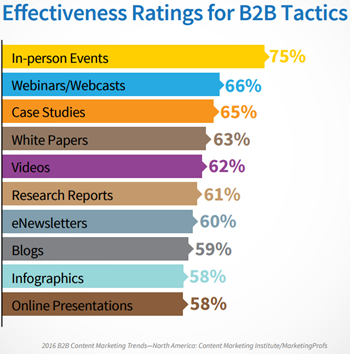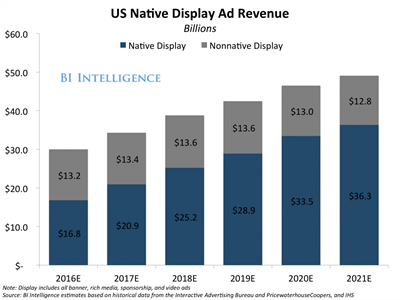7 Content Marketing Trends to Allocate Your 2017 Budget For
By Venus Tamturk
November 9, 2016
Advanced Analytics, B2B Content Marketing, Content Marketing Institute, Content Strategy, Customer Journey, marketing automation, online advertising, persona, personalization, Video Marketing
As the year is drawing to an end, in fact, there are fewer than 50 days remaining in 2016, it is about time to formulate the strategies and the budget that will help us as marketers deliver better results in 2017. Although building a strong foundation for your company’s continued growth sounds like a great idea, we are all aware of the hardship of annual budgeting. So before you pull out your crystal ball to make some assumptions, we have put some tactics together to help you navigate these daunting waters.
We all know that content marketing budgets differ, depending on the standard, size, type of brand and so on. But, one thing is certain, content marketing budgets are seeing an upswing. In fact, more than half of B2B marketers plan to increase their content marketing budget within the next year, even those who believe their content marketing to be ineffective, according to the Content Marketing Institute’s 2016 report.
Content Audit
 I couldn’t agree more with Gary Robbins, Partner, Brand and Demand Solutions at Frost & Sullivan, on its statement: “In an age of marketing transformation, it’s more important than ever to identify and leverage the best marketing strategies for your organization’s goals and budget. From social media and content marketing to “tried and true” approaches like live, in-person events and webinars, the key is choosing the right marketing mix for your business objectives.” First things first, to formulate a marketing budget that works for your company, you must take a hard look at what performed well and what didn’t throughout the year. The questions you should be asking yourself are:
I couldn’t agree more with Gary Robbins, Partner, Brand and Demand Solutions at Frost & Sullivan, on its statement: “In an age of marketing transformation, it’s more important than ever to identify and leverage the best marketing strategies for your organization’s goals and budget. From social media and content marketing to “tried and true” approaches like live, in-person events and webinars, the key is choosing the right marketing mix for your business objectives.” First things first, to formulate a marketing budget that works for your company, you must take a hard look at what performed well and what didn’t throughout the year. The questions you should be asking yourself are:
-
Why did these particular pieces perform better than others?
-
What type of content garnered remarkable attention?
-
Which subjects is your audience most interested in?
-
What’s the behavior flow? Do they drop-off after the landing page or keep interacting with other content?
Cutting funding to a marketing effort that is already working will result in slower growth. Therefore, if you have paid advertising in place, this is the best time to assess how it has been performing. Just because it is not working as much as expected doesn’t mean you should give up on advertising, rather, you should simply apply that budget to a different channel where your audience has a stronger presence. After assessing what worked and what didn’t this year, you should project the information into the future and get down to planning. Let’s discuss some tactics that will provide lucrative results.
Marketing Technology
According to Gartner, CMOs allocated 3.24% of revenue to technology, which is very close to the 3.4% of revenue CIOs earmark for IT. Marketing technology is no longer a relatively narrow and specialized adjunct to enterprise IT. Today we’re living in a world of 1,000+ marketing technology solutions, and in 2017, those technologies will garner investment nearly equivalent to the core systems that run the business.
Another important point that CMOs and CISOs will work together on is security. As expected, the stronger social presence a business has, the bigger the target they become for cyber criminals. Therefore in 2017, marketing and security teams will allocate budget more collaboratively in order to optimize their branding efforts in a safe manner.
Account Based Marketing (ABM)
Since ABM is a collaborative approach that engages sales, marketing, delivery, and key executives toward customers’ success, more and more companies are making ABM a key element in their 2017 marketing strategy. In fact, according to Frost&Sullivan, 80% of marketers measuring ROI say that ABM outperforms other marketing investments. Another recent study conducted by SiriusDecisions concluded that 92% of B2B companies call ABM “extremely important” to their overall marketing efforts, while 60% plan to invest in ABM in the next year.
If these numbers are not convincing enough, then hear out what Tony Yang, VP of Demand Generation at Mintigo, has to say about what makes ABM valuable for B2B organizations:
“ABM isn’t the way to go for every organization. But, if it’s right for yours, then the benefits are many. I’ll give you two aspects that make ABM so compelling in my opinion.First, having an ABM approach makes you much more laser-focused as a marketer. Jon Miller from Engagio likens ABM to fishing with spears compared to a traditional demand gen approach of ‘fishing with nets’. By knowing which accounts are the right ones, you zero in on the marketing channels that will help you engage with these accounts and tend to diminish your attention and resources on the channels that are too broad based.Second, many people say that the primary benefit of ABM is that it strengthens marketing and sales alignment. I agree with this wholeheartedly. In a traditional demand gen approach, marketing generates leads, ‘scores’ them to find potential good fit prospects, perhaps do some nurturing, and then throw them over the wall to sales to follow up. Sales will come back and say that the leads were not qualified. In an ABM approach, marketing becomes partners with, and enablers of, sales.”
you two aspects that make ABM so compelling in my opinion.First, having an ABM approach makes you much more laser-focused as a marketer. Jon Miller from Engagio likens ABM to fishing with spears compared to a traditional demand gen approach of ‘fishing with nets’. By knowing which accounts are the right ones, you zero in on the marketing channels that will help you engage with these accounts and tend to diminish your attention and resources on the channels that are too broad based.Second, many people say that the primary benefit of ABM is that it strengthens marketing and sales alignment. I agree with this wholeheartedly. In a traditional demand gen approach, marketing generates leads, ‘scores’ them to find potential good fit prospects, perhaps do some nurturing, and then throw them over the wall to sales to follow up. Sales will come back and say that the leads were not qualified. In an ABM approach, marketing becomes partners with, and enablers of, sales.”
A Video is Worth a Thousand Pictures
According to Dr. James McQuivey with Forrester, the one-minute video is equal to 1.8 million words. Isn’t that captivating? Do you know what else is? The statistics on video marketing. Here are some facts you definitely need to know:
-
Including video on a landing page can increase conversion rates by 80%.
-
92% of mobile video consumers share videos with others.
-
A video in a newsletter leads to 200-300 percent increase in click-through rate.
-
Users who watched a video are 64% more likely to buy a product online.
-
Cisco has released a very interesting prediction: “It would take an individual over 5 million years to watch the amount of video that will cross global IP networks each month in 2019.”
The list goes on and on. When you actually take a step back and think about why video content has become so popular, look no further than the authenticity it provides. In fact, even large companies with a tremendous ad budget do not hire rock stars or use high-polish videos for advertising anymore. Instead, there is a high demand for rough videos with live characters. The combination of this on-going trend with the technological progress enables businesses to produce videos for advertising with small marketing budgets. However, just because sinking quality standards in video production are okay, doesn’t mean compromising on the narrative quality of a story will be welcomed by your audience. The only way you can tackle video marketing is creating a stellar storyline for each video.
Cut Through the Over-Digitalization with Live Events
 In-person events help you not only develop deeper relationships with your stakeholders but they also generate great visual and authentic content that you can share with the world through static photographs, videos, or live streaming. It may allocate more budget than video production but in-person events, have been rated the most effective tactic for the last six years, increasing from 69% to 75% according to 2016 Marketing Profs/Content Marketing Institute B2B Survey. The survey also released that 81% of B2B marketers said they use in-person events as one of their content marketing tactics.
In-person events help you not only develop deeper relationships with your stakeholders but they also generate great visual and authentic content that you can share with the world through static photographs, videos, or live streaming. It may allocate more budget than video production but in-person events, have been rated the most effective tactic for the last six years, increasing from 69% to 75% according to 2016 Marketing Profs/Content Marketing Institute B2B Survey. The survey also released that 81% of B2B marketers said they use in-person events as one of their content marketing tactics.
Additionally, according to the latest market study released by Technavio, the global business-to-business (B2B) media market was valued at $29.61 billion, it is expected to reach $32.13 billion by 2020, and the top revenue generating type segment for the global B2B media market is events. The same study also found that nearly 85% of B2B marketers invest in events, 75% of them conduct one event every quarter, and 36% conduct an event every month.
“Events are the largest revenue stream in B2B media market mainly due to its ability to provide an interactive and immersive experience of the company's products and services to its potential customers. Events leave a lasting impression of the products and services in the market, making it the primary source of lead generation and helping in achieving a measurable ROI in future,” says Ujjwal Doshi, a Lead Analyst at Technavio.
During in-person events, live streaming is the best tactic to engage with not only the attendees but also the audience that can’t make the event. Making and sharing the live video across your social channels is much simpler than in years past as today’s marketplace provides some really good products which can syndicate live video content to Facebook, YouTube, Ustream, and everywhere, all from one stream.
My final note on live events is to not ever think your organization is simply not big enough to pursue this tactic, as everyone is not supposed to throw huge events. In fact, the opportunity cost can easily add up to be more than your total cost of ownership of more intimate events. Regardless of the size of events, do not underestimate the power of showcasing your thought leadership and positioning your business as a peer, rather than a solution provider.
Native Advertising
First, I would like to briefly explain this term for those who are not familiar. Native advertising is a paid  placement in which the ad blends in with the look and format of the surrounding content. In other words, advertising that mimics the environment it’s delivered in. It’s important to know that content marketing and native advertising are not interchangeable as content marketing is the overarching strategy whereas native advertising is one tactic of execution.
placement in which the ad blends in with the look and format of the surrounding content. In other words, advertising that mimics the environment it’s delivered in. It’s important to know that content marketing and native advertising are not interchangeable as content marketing is the overarching strategy whereas native advertising is one tactic of execution.
A report released by PulsePoint and Digiday found that by 2017, native ad budgets will grow 46% respectively; potentially outpacing search and social budgets. The strongest driver behind this trend is that ad-blocking technology has flooded the market and continues to increase in adoption as consumers do not want to consume ads, instead, they want to intentionally consume valuable content. If a consumer doesn’t have an ad-blocker technology in place, that doesn't mean that they can be reached with banners, pop-ups, paid ads, and pop-unders. As a result of increasing general distaste for online advertising, consumers took matters into their own hands. Therefore the market size is expected to double to $21 billion by 2018.
On the other hand, this tactic doesn’t work for everyone. There is no point in allocating a huge portion of your marketing budget to media buying if you aren’t able to supplement that ad with quality content. The content should be useful, interesting, and highly targeted to a specific audience, not to even mention it shouldn’t be directly promoting the company’s product or service. After all, the idea behind native advertising is delivering helpful information on a third-party content distribution platform in a format similar to the other content on the site, so the user experience wouldn’t be disrupted.
Since native advertising won’t come cheaply, it’s so critical to get strategy and planning done right in order to get the most out of your campaign. At the end of the day, the content you designate to this campaign should present your company as an authority in the topic at hand.
Personalized Content
Personalization has gone beyond inserting “Hello <First_Name>, <Last_Name>" into an email. If you consider yourself to be generating personalized content because you are sending a newsletter by your audience’s name, then it is about time to change your perception. We are, here at CMS-Connected, consistently covering the news of acquisitions and partnerships between every size of tech company in an effort to integrate personalization capabilities more tightly into their platforms. We often talk about what the deals are worth to a billion dollars, so there is no doubt that you should allocate some budget to deliver personalized experiences.
Investing in marketing automation platforms can be a smart idea as they can help marketers increase website traffic, streamline marketing processes, and nurture prospects with personalized communications along the customer journey. 80% of a customer’s buying journey happens before they ever interact with sales, and ironically it is where the majority of marketing budgets are spent. Therefore, we’ll see more organizations allocate a significant budget for the personalized content creatio, and the technology that can help marketers have a better track on the buyers’ journey and control over optimizing every touchpoint.
Frankly, annual budgeting is not an easy task and can result in a blessing, but sometimes a curse. You can take comfort in knowing that you're not alone as many of us feel the pain. However, a well-planned budget that breaks down each activity with clear expectations of the investment you’re putting in, and the value you’re getting out, can help you avoid sweating and give you control over each marketing task with a strong focus. With 2017 pretty much nipping at our heels, we would love to have a meaningful conversation below on your plans to make your marketing budget a worthwhile investment?

Venus Tamturk
Venus is the Media Reporter for CMS-Connected, with one of her tasks to write thorough articles by creating the most up-to-date and engaging content using B2B digital marketing. She enjoys increasing brand equity and conversion through the strategic use of social media channels and integrated media marketing plans.